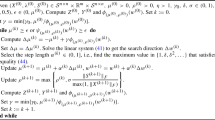Abstract
In this paper, we present a majorized semismooth Newton-CG augmented Lagrangian method, called SDPNAL\(+\), for semidefinite programming (SDP) with partial or full nonnegative constraints on the matrix variable. SDPNAL\(+\) is a much enhanced version of SDPNAL introduced by Zhao et al. (SIAM J Optim 20:1737–1765, 2010) for solving generic SDPs. SDPNAL works very efficiently for nondegenerate SDPs but may encounter numerical difficulty for degenerate ones. Here we tackle this numerical difficulty by employing a majorized semismooth Newton-CG augmented Lagrangian method coupled with a convergent 3-block alternating direction method of multipliers introduced recently by Sun et al. (SIAM J Optim, to appear). Numerical results for various large scale SDPs with or without nonnegative constraints show that the proposed method is not only fast but also robust in obtaining accurate solutions. It outperforms, by a significant margin, two other competitive publicly available first order methods based codes: (1) an alternating direction method of multipliers based solver called SDPAD by Wen et al. (Math Program Comput 2:203–230, 2010) and (2) a two-easy-block-decomposition hybrid proximal extragradient method called 2EBD-HPE by Monteiro et al. (Math Program Comput 1–48, 2014). In contrast to these two codes, we are able to solve all the 95 difficult SDP problems arising from the relaxations of quadratic assignment problems tested in SDPNAL to an accuracy of \(10^{-6}\) efficiently, while SDPAD and 2EBD-HPE successfully solve 30 and 16 problems, respectively. In addition, SDPNAL\(+\) appears to be the only viable method currently available to solve large scale SDPs arising from rank-1 tensor approximation problems constructed by Nie and Wang (SIAM J Matrix Anal Appl 35:1155–1179, 2014). The largest rank-1 tensor approximation problem we solved (in about 14.5 h) is nonsym(21,4), in which its resulting SDP problem has matrix dimension \(n = 9261\) and the number of equality constraints \(m =12{,}326{,}390\).

Similar content being viewed by others
References
Arnold, V.I.: On matrices depending on parameters. Russ. Math. Surv. 26, 29–43 (1971)
Bonnans, J.F., Shapiro, A.: Perturbation Analysis of Optimization Problems. Springer, Berlin (2000)
Borwein, J.M., Lewis, A.S.: Convex Analysis and Nonlinear Optimization: Theory and Examples, vol. 3. Springer, Berlin (2006)
Burer, S.: On the copositive representation of binary and continuous nonconvex quadratic programs. Math. Program. 120, 479–495 (2009)
Burer, S., Monteiro, R.D., Zhang, Y.: A computational study of a gradient-based log-barrier algorithm for a class of large-scale sdps. Math. Program. 95, 359–379 (2003)
Chen, C., He, B., Ye, Y., Yuan, X.: The direct extension of admm for multi-block convex minimization problems is not necessarily convergent. Math. Program. (to appear)
Eisenblätter, A., Grötschel, M., Koster, A.M.: Frequency planning and ramifications of coloring. Discuss. Math. Graph Theory 22, 51–88 (2002)
Hahn, P., Anjos, M.: QAPLIB—a quadratic assignment problem library. http://www.seas.upenn.edu/qaplib
Hiriart-Urruty, J.-B., Strodiot, J.-J., Nguyen, V.H.: Generalized Hessian matrix and second-order optimality conditions for problems with \(C^{1,1}\) data. Appl. Math. Optim. 11, 43–56 (1984)
Monteiro, R., Ortiz, C., Svaiter, B.: A first-order block-decomposition method for solving two-easy-block structured semidefinite programs. Math. Program. Comput. 6, 103–150 (2014)
Moreau, J.J.: Décomposition orthogonale d’un espace hilbertien selon deux cones mutuellement polaires. C. R. Acad. Sci. 255, 238–240 (1962)
Nie, J., Wang, L.: Regularization methods for SDP relaxations in large-scale polynomial optimization. SIAM J. Optim. 22, 408–428 (2012)
Nie, J., Wang, L.: Semidefinite relaxations for best rank-1 tensor approximations. SIAM J. Matrix Anal. Appl. 35, 1155–1179 (2014)
Pang, J.-S., Sun, D.-F., Sun, J.: Semismooth homeomorphisms and strong stability of semidefinite and lorentz complementarity problems. Math. Oper. Res. 28, 39–63 (2003)
Peng, J., Wei, Y.: Approximating k-means-type clustering via semidefinite programming. SIAM J. Optim. 18, 186–205 (2007)
Povh, J., Rendl, F.: Copositive and semidefinite relaxations of the quadratic assignment problem. Discret. Optim. 6, 231–241 (2009)
Rockafellar, R.T.: Conjugate duality and optimization. CBMS-NSF Regional Conf. Ser. Appl. Math. vol. 16. SIAM, Philadelphia (1974)
Rockafellar, R.T.: Augmented Lagrangians and applications of the proximal point algorithm in convex programming. Math. Oper. Res. 1, 97–116 (1976)
Rockafellar, R.T.: Monotone operators and the proximal point algorithm. SIAM J. Control Optim. 14, 877–898 (1976)
Sloane, N.: Challenge problems: independent sets in graphs. http://www.research.att.com/njas/doc/graphs.html (2005)
Sun, D.-F., Sun, J.: Semismooth matrix-valued functions. Math. Oper. Res. 27, 150–169 (2002)
Sun, D.-F., Toh, K.-C., Yang, L.-Q.: A convergent 3-block semi-proximal alternating direction method of multipliers for conic programming with 4-type constraints. SIAM J. Optim. (to appear)
Toh, K.C.: Solving large scale semidefinite programs via an iterative solver on the augmented systems. SIAM J. Optim. 14, 670–698 (2004)
Trick, M., Chvatal, V., Cook, B., Johnson, D., McGeoch, C., Tarjan, R.: The second dimacs implementation challenge—NP hard problems: maximum clique, graph coloring, and satisfiability. http://dimacs.rutgers.edu/Challenges/ (1992)
Wen, Z., Goldfarb, D., Yin, W.: Alternating direction augmented Lagrangian methods for semidefinite programming. Math. Program. Comput. 2, 203–230 (2010)
Zhao, X.-Y., Sun, D.-F., Toh, K.-C.: A Newton-CG augmented Lagrangian method for semidefinite programming. SIAM J. Optim. 20, 1737–1765 (2010)
Acknowledgments
The authors would like to thank Jiawang Nie and Li Wang for sharing their codes on semidefinite relaxations of rank-1 tensor approximation problems.
Author information
Authors and Affiliations
Corresponding author
Additional information
D. Sun’s research was supported in part by the Academic Research Fund under Grant R-146-000-149-112. K.-C. Toh’s research supported in part by the Ministry of Education, Singapore, Academic Research Fund under Grant R-146-000-194-112.
Rights and permissions
About this article
Cite this article
Yang, L., Sun, D. & Toh, KC. SDPNAL\(+\): a majorized semismooth Newton-CG augmented Lagrangian method for semidefinite programming with nonnegative constraints. Math. Prog. Comp. 7, 331–366 (2015). https://doi.org/10.1007/s12532-015-0082-6
Received:
Accepted:
Published:
Issue Date:
DOI: https://doi.org/10.1007/s12532-015-0082-6




